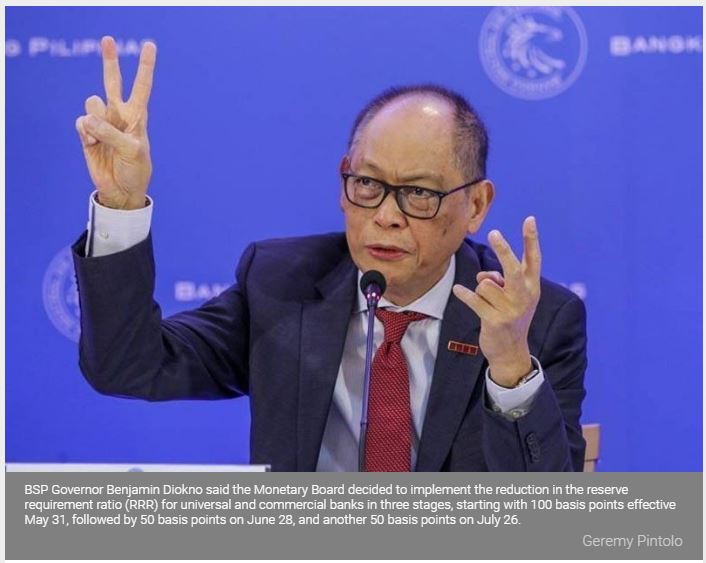Philippines: BSP cuts bank reserve ratio to 16%
MANILA, Philippines — The Bangko Sentral ng Pilipinas (BSP) has brought down the level of deposits banks are required to keep with the central bank by 200 basis points (two percentage points) over a three-month period, releasing about P190 billion in additional funds to boost the slowing economy.
BSP Governor Benjamin Diokno said the Monetary Board decided to implement the reduction in the reserve requirement ratio (RRR) for universal and commercial banks in three stages, starting with 100 basis points effective May 31, followed by 50 basis points on June 28, and another 50 basis points on July 26.
“This new policy will apply to universal and commercial banks only. For the other types of banks, the cut in RRR will be considered in the next Monetary Board meeting,” Diokno said.
The fresh reduction would bring the RRR level to 16 percent from the current 18 percent, and would remain the highest in the region.
The new policy came exactly a week after the Monetary Board reversed its tightening cycle through a reduction in key interest rates by 25 basis points on the back of easing inflation as well as the lower-than-expected gross domestic product (GDP) growth in the first quarter of the year.
Inflation eased for six straight months to hit a 16-month low of three percent in April, after peaking at 6.7 percent in September and October last year.
It would be recalled the Monetary Board lifted benchmark rates by 175 basis points in five rate-setting meetings from May to November to anchor inflation expectations as inflation averaged 5.2 percent last year from 2.9 percent in 2017 and exceeded the BSP’s two to four percent target due to elevated oil and food prices as well as the weak peso.
On the other hand, the Philippines posted its slowest GDP growth in four years at 5.6 percent in the first quarter of the year, lower than the expected six percent and the 6.3 percent recorded in the fourth quarter of last year.
BSP Deputy Governor Diwa Guinigundo said the move would release more or less P190 billion into the financial system as P90 to P95 billion worth of funds are injected into the economy for every one percentage point cut in RRR.
But the reduction in the RRR level is inflationary as it releases more funds into the financial system, prompting some members of the Monetary Board to oppose the move.
ING Bank Manila senior economist Nicholas Mapa said now is the perfect opportunity for the BSP to cut both the policy rate as well as the RRR after the GDP growth in the first quarter dropped to 5.6 percent.
After slamming hard on the proverbial brakes in the third quarter by jacking up rates by 175 basis points, Mapa said the central bank believed it was time to give the economy a much needed breather especially with the inflation objective well in hand.
Mapa added liquidity conditions also remained tight as growth in money supply remained in single-digit over the past seven months hitting its slowest level in more than a decade at 4.2 percent in March.
He said the gradual reduction in RRR would definitely help alleviate the current tight liquidity conditions and complements its recent policy rate cut.
“With liquidity conditions tight, as evidenced by seven months of single digit M3 growth and multi-year high time deposit rates, BSP looked to finally address the lack of funds circulating in the system. Deploying the appropriate tool to address specific ailments was key in this round of decisions despite being tempted to deploy one tool to address all concerns,” Mapa said.
Last year, the BSP also slashed the RRR level twice in March and June by a cumulative 200 basis points to 18 percent from 20 percent.
Source: https://www.philstar.com/business/2019/05/17/1918395/bsp-cuts-bank-reserve-ratio-16#EVLEbgxERd7PFX8P.99


 English
English




